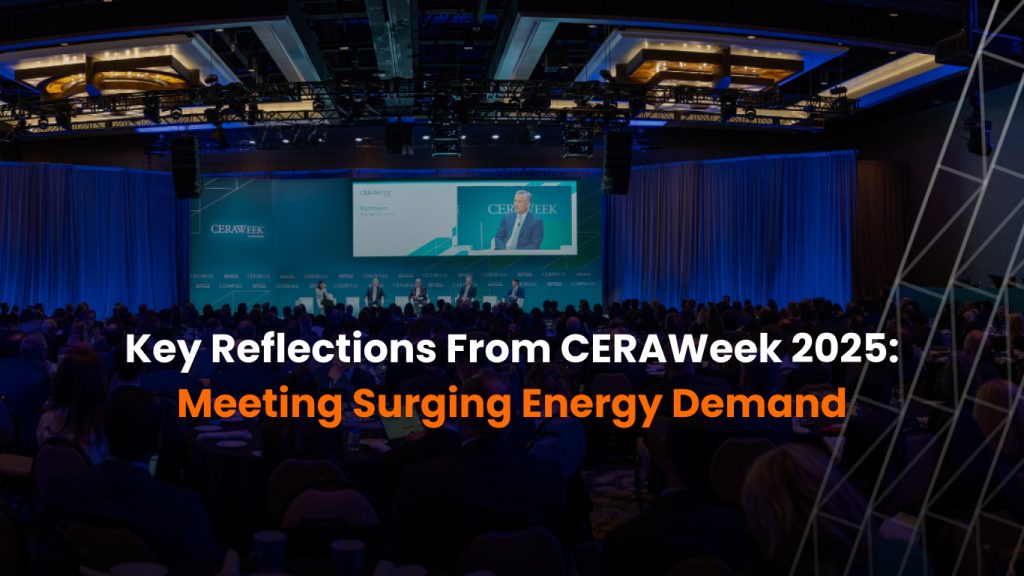Introduction
Each year, the CERAWeek conference convenes energy leaders from around the world, and CERAWeek 2025 proved especially illuminating. Faced with geopolitical shifts, climate goals, and technological disruption, the industry is grappling with how to supply ever-growing energy demand in a reliable, affordable, and sustainable way. The key message out of Houston (where the conference was held) was that meeting this surging demand will require an “all of the above” strategy. In other words, rather than a single silver bullet, a diverse array of energy solutions – from natural gas to renewables to new tech innovations – must work in concert.
In this blog, we reflect on the top themes and takeaways from CERAWeek 2025. These insights range from the enduring role of fossil fuels (albeit cleaner and more efficient) to the rapid rise of green data centers and microgrids, and the increasing intertwining of energy policy with global events. Whether you’re in the solar industry, utilities, or a power consumer, these trends shed light on how the energy landscape is evolving to meet the challenges of the next decade.
Surging Demand Calls for “Energy Addition,” Not Just Transition
One striking refrain at the conference was the concept of “energy as an addition, not a transition.” Industry leaders emphasized that the world’s energy appetite is expanding so fast that we need all forms of energy to grow, rather than thinking we can simply swap one source for another immediately. The reality check is that global electricity demand is expected to balloon by the end of this decade, driven by economic growth and new uses like electric vehicles and data centers. In fact, data centers alone could account for 7.5% of U.S. electricity use by 2030 (up from 2.5% in 2022), and EV adoption could add significant load to grids worldwide.
Speakers noted that after years of flat demand, electricity consumption is now on a sharp upswing – potentially 20% higher in the U.S. by 2030. Simultaneously, to achieve climate targets, much of this new demand ideally should be met with low-carbon sources. But practically, completely transitioning away from fossil fuels overnight is infeasible without risking shortages. Thus, the narrative at CERAWeek was about addition: continuing to develop renewables and investing in cleaner use of fossil fuels, and exploring nuclear and other sources. It’s an inclusive strategy.
For example, natural gas was repeatedly highlighted as a secure, low-cost energy source that will underpin reliability even as renewables expandi. Attendees pointed out that gas infrastructure and generation will help prevent blackouts during the transition, providing the cushion needed as we build out wind, solar, and batteries. At the same time, interest in nuclear energy saw a revival at CERAWeek 2025 – not the traditional large reactors only, but also small modular reactors (SMRs) – with announcements like major tech companies (Amazon, Google) pledging to invest in tripling nuclear capacity by 2050. This underscores a long-term view: an eventual clean energy mix that is broad (solar, wind, nuclear, hydro, etc.), supplemented by storage, but with gas ensuring the stability along the way.
The consensus was that energy demand will be met by addition of all sources. This approach acknowledges that we can’t simply subtract coal and gas tomorrow without destabilizing supply; instead we add huge amounts of clean energy, gradually reduce the share of high-carbon fuels (coal first, then eventually unabated gas), but continue to use every tool available to avoid an energy crunch. It’s a pragmatic stance given current technology and geopolitical realities.
Diverse Solutions: From Green Data Centers to Microgrids
A major focus was on which energy solutions and technologies can rise to the challenge of surging demand while also aligning with climate and resilience goals. CERAWeek 2025 spotlighted a suite of innovations and strategies, many of which are already available today, to ensure timely and affordable power:
- Green Data Centers: Data centers themselves were a hot topic, being both large energy consumers and, paradoxically, potential energy assets. “Green data centers” refers to facilities optimized for energy efficiency and powered by clean energy. We heard how hyperscalers (big tech firms) are deploying on-site battery storage and solar panels to make their data centers not only reliable but also grid-friendly. For instance, by using batteries, data centers can shave peak grid usage and even provide services back to the grid (as Google did in Belgium, replacing diesel backups with a battery that aids the local grid). This trend reduces strain on the grid and serves the growth in digital demand with less carbon footprint. Operators are also siting data centers in locations with abundant renewable energy or cooler climates (to cut cooling needs), and utilizing waste heat from servers for other purposes. The reflection from CERAWeek: as digital demand soars, making data centers as energy-efficient and self-sustaining as possible will significantly help meet power needs without proportionally increasing grid stress.
- “Reshape” – Demand Side Management: The concept of Reshape was mentioned as an important tool – essentially, shaping or shifting energy consumption to match supply. Smart grids and IoT allow for more sophisticated demand response programs. For example, large industrial users or even aggregated residential devices (like smart thermostats, EV chargers) can reduce or time-shift their usage during critical peak periods. At the conference, this was highlighted as a cost-effective way to free up capacity. It’s cheaper and faster to reduce demand for an hour than to build a new power plant for that same hour’s need. Several utilities shared success stories of demand response averting blackouts during heatwaves or cold snaps by getting customers to conserve or use backup generators temporarily. As one speaker put it, “the cleanest and cheapest kilowatt is the one you don’t have to produce.” Thus, “reshaping” demand is a key part of meeting surging energy needs – essentially, optimization on the consumption side, enabled by AI and connected devices.
- Combined Heat & Power (CHP): CHP (also called cogeneration) got attention as a way to squeeze more usefulness out of fuel. A CHP system produces electricity and captures the waste heat for heating buildings or industrial processes, achieving overall efficiencies of 70-80% or more. CERAWeek discussions noted that CHP can play a role in commercial campuses, hospitals, and industrial parks to reduce burden on the grid. For example, a university might run a gas-fired CHP plant that meets its electric needs and provides steam for campus heating/cooling. This reduces the net energy drawn from the grid and makes use of fuel much more efficiently than separate power and heat systems. Modern CHP units can even run on biofuels or hydrogen blends, aligning with lower-carbon goals. Essentially, CHP is a way to meet localized energy demand surges without solely relying on grid supply, and it’s available tech today.
- Linear Generators: A newer technology introduced was linear generators, which are compact devices that generate power using a linear motion (as opposed to traditional rotating turbines). Companies like Mainspring Energy have developed linear generators that can run on various fuels (natural gas, biogas, hydrogen) and ramp up and down very quickly. They produce lower emissions and offer a flexible distributed generation option. At CERAWeek, linear generators were showcased as a promising replacement for diesel gensets or a supplement to microgrids because of their responsiveness and fuel flexibility. They represent how innovation in generation tech is providing more options to meet demand spikes cleanly and efficiently. One could imagine, for example, a big-box store or a data center having a few linear generator units on-site that kick in during peak hours or grid outages, ensuring reliability and shaving load off the grid.
- Microgrids and Decentralization: Microgrids were a big theme in the context of resilience and local demand. A microgrid is a self-contained network of generators, storage, and loads that can disconnect (island) from the main grid if needed. CERAWeek underscored that in an era of more frequent extreme weather, having microgrids for critical infrastructure (and even neighborhoods) is crucial. They enable essential services to keep running and also allow more localized optimization of resources. For instance, a community microgrid might integrate rooftop solar, a battery, and a backup gas generator to ensure power 24/7, independent of the broader grid’s troubles. Conference speakers noted that microgrids, often leveraging renewable energy and batteries, are now much more feasible due to cost declines in solar and storage, and advancements in control technology. Some utility executives described pilot programs where they support customers in setting up microgrids that can reduce load on the main grid during peak times or emergencies. In essence, microgrids can meet local demand growth without as much central generation, and provide a layer of security.
- Battery Energy Storage: It almost goes without saying, but battery storage was heralded as a linchpin solution at CERAWeek 2025. There was talk of how nearly 4 GW of battery storage was added in the U.S. in one recent quarter – a sign of exponential growth. Batteries are addressing the age-old mismatch between when energy is produced and when it’s needed. Key reflections included: use of batteries at utility-scale for peak shaving and frequency regulation, at commercial sites like factories or malls to cut peak charges, and aggregated in neighborhoods (e.g., rooftop solar homes with Powerwall-type batteries collectively easing grid demand at night). The overall takeaway: battery storage has moved from experimental to essential in meeting demand surges, and its role will only increase. However, experts also cautioned that current battery chemistries typically provide 4-8 hours of storage; longer gaps (multi-day) still require solutions like natural gas or emerging tech. So, batteries are a big piece of the puzzle, but not the sole answer for all reliability concerns.
The unifying point among these diverse solutions is that they are comparatively low-cost now and ready to deploy (as was emphasized at the conference). None of these are distant future tech; they are available to be scaled today. That is encouraging, because it means the industry has tools in hand to tackle demand growth without solely defaulting to building massive new fossil fuel plants everywhere.
Due to their comparatively low cost and availability, many of these solutions are seeing rapid adoption. This was highlighted as a positive feedback loop: the more they scale, the cheaper they get, leading to further adoption. For example, every additional gigawatt of battery manufacturing lowers battery prices, making storage even more economically attractive to deploy for peak management.
Geopolitics and Policy: The Context for Energy Strategies
CERAWeek 2025 didn’t happen in a vacuum; global events cast a long shadow on the discussions. A few contextual factors were repeatedly noted, as they directly affect how we meet energy demand:
- Global Conflicts and Energy Security: The ongoing Russia-Ukraine conflict and recent trade tensions (like a U.S.-Canada trade squabble over pipelines) have put energy security at the forefront. European attendees spoke about efforts to diversify away from Russian gas – which in the short term meant more LNG and renewables, but also highlighted gas’s importance in energy security calculus. In the U.S., talk of an “America First energy dominance” agenda under the new administration (President Trump returning in 2025, as context) was noted. This has meant prioritizing domestic production of oil and gas and easing some fossil fuel regulations, which could lead to more supply. The takeaway: geopolitics can shift focus back to reliability and domestic self-sufficiency. Countries are looking to ensure they have enough firm power (often gas or coal reserves) to withstand supply shocks, even as they build out renewables. So policy is juggling energy transition goals with short-term energy security needs.
- Tariffs and Trade Policies: A surprising theme was how trade wars and tariffs are impacting energy. Fluctuating tariffs on solar panels, batteries, and even critical minerals can affect deployment rates. At the conference, there was buzz about U.S.-China trade issues and North American trade spats influencing supply chains for energy projects. Tariffs on imported solar modules, for instance, could slow solar farm installations in the U.S., thereby affecting how quickly renewables can contribute to meeting demand. Similarly, tariffs on steel or equipment raise costs for grid infrastructure and gas pipelines. Industry leaders called for stable trade policies or at least mitigation strategies (like onshoring manufacturing of clean tech) to ensure the energy transition isn’t stalled by trade barriers.
- Policy Uncertainty and Investment: Another reflection was concern over policy whiplash. With changes in political leadership, energy policies can swing – subsidies, carbon regulations, drilling approvals, etc. For example, the contrast of a pro-fossil fuel U.S. administration in 2025 vs. the prior pro-renewables stance created some uncertainty in long-term planning. Despite this, the private sector seemed committed to pushing ahead with clean energy investments, recognizing both market demand and the inevitability of carbon constraints in the future. However, a stable policy environment was seen as key to accelerating projects. Frequent mentions were made of the U.S. Inflation Reduction Act (IRA) of 2022, which provided huge incentives for clean energy – industry players want such programs to remain intact, as they drive much of the current renewable and storage build-out. Conversely, there was trepidation that if such incentives were rolled back, it could slow the addition of these new resources needed for demand.
- Climate Goals vs. Realpolitik: The mood at CERAWeek balanced optimism about new technology with realism about the current energy mix. While there’s enthusiasm for eventually achieving net-zero emissions, there was also candid acknowledgment that in the near term, fossil fuels (especially natural gas) are not only sticking around but expanding in some areas to ensure reliable supply. This was not portrayed as a step back from climate commitment, but as a necessary step to avoid energy shortages and price spikes which themselves can erode public support for climate policies. Essentially, there’s a recognition that the transition must be managed such that energy remains affordable and secure, or else backlash could undermine the entire effort. Therefore, many executives advocated for investing in emissions-reducing technologies for gas and oil (like carbon capture, methane leak reduction, efficiency improvements) as a pragmatic way to reconcile climate goals with on-the-ground energy needs.
Cautious Optimism: An “All of the Above” Energy Future
The overall tone of CERAWeek 2025 was one of cautious optimism. Yes, challenges are immense – demand is rising, climate change pressures intensify, geopolitical tensions abound – but the industry is more and more equipped with solutions and strategies to handle it. There was a palpable sense that an “all of the above” approach is not just rhetoric but being actualized: we see simultaneous investments in natural gas capacity and renewable farms, in battery storage and grid expansion, in maintaining existing nuclear power while exploring next-gen reactors.
One panelist quipped that 20 years ago the debate was “renewables versus fossil fuels,” but now it’s “how do we make the most of both plus everything else.” This captures the current ethos. The key reflection is that diversity equals resiliency in energy. By diversifying energy sources, supply chains, technologies, and even decentralizing generation (via microgrids, DERs), we build a more resilient system that can handle shocks and meet growth.
CERAWeek 2025 reinforced that the energy industry is in a period of profound transformation but is approaching it in a pragmatic way. Innovation is high – AI and digitalization are making the system smarter (for instance, managing complex interactions of all these resources). There’s also a cultural shift: oil & gas companies at the conference spoke of themselves as “energy companies” now, many showcasing investments in renewables, hydrogen, or carbon capture projects. Likewise, renewable companies talked about grid reliability and firming – areas traditionally outside their scope – because they recognize the importance of working holistically.
In conclusion, the key reflections from CERAWeek 2025 can be summed up as:
- We need more energy, from all sources – manage the transition by adding new clean capacity aggressively, while keeping sufficient traditional capacity for reliability.
- Multiple tools are ready now – including gas, renewables, storage, efficiency, CHP, microgrids, etc., and all should be deployed for their respective strengths in meeting demand
- Resilience and flexibility are the name of the game – given uncertainty (in climate, politics, geopolitics), building an energy system that can flex and adapt (via diverse supply and smart grids) is critica.
- Policy and collaboration matter – stable incentives, international cooperation on supply chains, and partnerships between different energy sectors (fossil and renewable, public and private) will determine how smoothly we ride the energy journey of the next decade.
The future painted at CERAWeek 2025 is not one of choosing solar OR gas OR nuclear, but one of leveraging solar AND gas AND nuclear AND more. It’s an inclusive, albeit complex, strategy but one that attendees believed is necessary to fuel a growing world sustainably and reliably.
As we move forward, these insights from global energy leaders will likely guide investment and policy decisions. For anyone involved in energy – whether installing solar panels on rooftops, operating wind farms, running a utility, or managing an energy-intensive business – the takeaway is clear: be prepared to integrate multiple solutions and remain agile. The energy landscape of the 2020s is dynamic, and meeting the surging demand will be a shared effort across technologies and industries.




